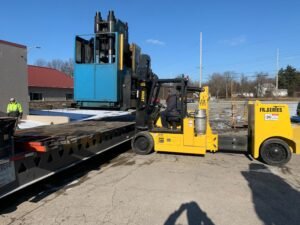Shipping crates are essential for the safe transport of goods, providing protection from damage and facilitating easy handling. Understanding the different types of crates available and their specific uses is crucial for ensuring the secure and efficient shipment of various items. This comprehensive guide will explore the various types of shipping crates, their construction materials, advantages and disadvantages, and practical tips for selecting the right crate for your shipping needs.
Importance of Using the Right Crate
Using the appropriate crate for shipping offers several benefits:
1. Protection: Proper crates shield goods from physical damage, moisture, and environmental factors.
2. Efficiency: Well-chosen crates simplify loading, unloading, and storage.
3. Compliance: Certain crates meet regulatory requirements for international shipping.
4. Cost-effectiveness: Selecting the right crate can reduce shipping costs and minimize the risk of damage-related expenses.
Types of Shipping Crates
1. Wooden Crates
Wooden crates are among the most commonly used types for shipping. They come in various designs and can be customized to fit specific requirements.
a. Standard Wooden Crates
Standard wooden crates are constructed from wood planks or plywood, offering a sturdy option for shipping various items.
Advantages:
- Strong and durable.
- Can be customized in size and shape.
- Suitable for heavy or bulky items
Disadvantages:
- Can be heavy, increasing shipping costs.
- May require treatment for international shipping to prevent pest infestation.
b. Plywood Crates
Plywood crates are made from sheets of plywood, providing a lightweight yet strong option.
Advantages:
- Lighter than solid wood crates.
- Good strength-to-weight ratio.
- Easy to assemble and disassemble.
Disadvantages:
- Less durable than solid wood.
- May not be suitable for extremely heavy items.
c. ISPM 15 Crates
ISPM 15 crates are treated to meet international shipping regulations, preventing the spread of pests.
Advantages:
- Compliant with international shipping standards.
- Prevents pest infestations.
Disadvantages:
- Additional cost for treatment.
- Limited availability in some regions.
2. Plastic Crates
Plastic crates are made from durable plastic materials and are used for a variety of shipping needs.
a. High-Density Polyethylene (HDPE) Crates
HDPE crates are robust and resistant to impact and chemicals.
Advantages:
- Lightweight and durable.
- Resistant to moisture and chemicals.
- Reusable and easy to clean.
Disadvantages:
- Can be more expensive than wooden crates.
- Not as strong for extremely heavy items.
b. Polypropylene Crates
Polypropylene crates offer similar benefits to HDPE crates but with different material properties.
Advantages:
- High strength and rigidity.
- Resistant to fatigue and stress.
Disadvantages:
- Higher cost compared to HDPE.
- May not be suitable for all types of goods.
c. Collapsible Plastic Crates
Collapsible plastic crates can be folded when not in use, saving storage space.
Advantages:
- Space-saving design.
- Lightweight and easy to handle.
Disadvantages:
- Limited to lighter loads.
- May not provide as much protection as rigid crates.
3. Metal Crates
Metal crates are made from materials such as steel or aluminum, providing a robust solution for shipping.
a. Steel Crates
Steel crates are extremely strong and can handle heavy loads.
Advantages:-
- High strength and durability.
- Suitable for very heavy or valuable items.
- Resistant to damage and tampering.
Disadvantages:
- Very heavy, increasing shipping costs.
- Can be prone to rust if not properly treated.
b. Aluminum Crates
Aluminum crates offer a lighter alternative to steel crates with good strength.
Advantages:
- Lightweight and strong.
- Resistant to corrosion.
Disadvantages:
- More expensive than steel.
- Less impact-resistant than steel.
4. Composite Crates
Composite crates are made from a combination of materials, such as wood and plastic, providing a balanced option for shipping.
a. Wood-Plastic Composite Crates
These crates combine wood fibers with plastic to create a durable and versatile crate.
Advantages:
- Lightweight and strong.
- Resistant to moisture and pests.
- Environmentally friendly option using recycled materials.
Disadvantages:
- Can be more expensive than traditional wood or plastic crates.
- Limited availability.
Construction and Features of Shipping Crates
1. Construction Techniques
Different construction techniques affect the strength and functionality of shipping crates.
a. Nailed and Screwed Joints
Nailed and screwed joints provide strong connections for wooden crates.
Advantages:
- Easy to assemble and disassemble.
- Strong and durable connections.
Disadvantages:
- May require tools for assembly.
- Screws can loosen over time.
b. Welded Joints
Welded joints are used in metal crates for maximum strength.
Advantages:
- Very strong and durable.
- Tamper-resistant.
Disadvantages:
- Permanent connections.
- Requires specialized equipment for assembly.
c. Molded Construction
Molded construction is used for plastic crates, creating a seamless design.
Advantages:
- Lightweight and strong.
- No weak points from joints.
Disadvantages:
- Limited customization options.
- Higher initial cost.
2. Special Features
Additional features can enhance the functionality of shipping crates.
a. Handles and Latches
Handles and latches improve handling and security.
Advantages:
- Easier to carry and transport.
- Secure closures to prevent tampering.
Disadvantages:
- Can add weight and cost.
- May require regular maintenance.
b. Locking Mechanisms
Locking mechanisms provide added security for valuable items.
Advantages:
- Protects against theft and tampering.
- Suitable for high-value shipments.
Disadvantages:
- Additional cost.
- Requires compatible locking systems.
c. Ventilation and Drainage
Ventilation and drainage features are essential for certain types of goods.
Advantages:
- Prevents moisture buildup and mold.
- Suitable for perishable goods.
Disadvantages:
- May not be necessary for all shipments.
- Can reduce overall strength of the crate.
Choosing the Right Crate
1. Assessing Shipping Needs
Understanding your specific shipping needs is the first step in selecting the right crate.
a. Type of Goods
Identify the type of goods being shipped and their specific requirements.
Fragile Items: Require additional padding and protection.
Heavy Items: Need strong, durable crates.
Perishable Items: Require ventilation and temperature control.
b. Destination
Consider the destination and any special requirements.
International Shipping: May require ISPM 15 compliant crates.
Remote Locations: Need durable and easy-to-handle crates.
c. Handling and Transportation
Think about how the crates will be handled and transported.
Manual Handling: Lightweight and easy-to-carry crates.
Forklift Handling: Crates with reinforced bottoms and easy access points.
2. Budget Considerations
Budget plays a significant role in crate selection.
a. Initial Cost vs. Long-Term Savings
Evaluate the initial cost of the crate against potential long-term savings.
Reusable Crates: Higher initial cost but save money over time.
Disposable Crates: Lower cost but may need to be replaced frequently.
b. Cost of Damage
Consider the cost of potential damage if the wrong crate is used.
High-Value Goods: Invest in higher-quality, secure crates.
Low-Value Goods: Budget-friendly options may suffice.
3. Environmental Impact
Assess the environmental impact of your crate choice.
a. Recyclable Materials
Opt for crates made from recyclable materials to reduce environmental impact.
b. Reusability
Choose reusable crates to minimize waste and lower overall costs.
Case Studies
1. High-Tech Electronics Shipping
A company shipping high-tech electronics needed crates that provided excellent protection against physical damage and moisture. They opted for custom plywood crates with foam padding and silica gel packets. This choice ensured the electronics arrived safely and intact, minimizing potential damage and loss.
2. Heavy Machinery Transport
A manufacturer of heavy machinery required strong and durable crates for shipping their products. They selected steel crates with welded joints, providing the necessary strength and protection. Despite the higher cost, the investment paid off by preventing damage during transport and ensuring customer satisfaction.
3. Perishable Goods Delivery
A food distribution company needed crates for shipping perishable goods such as fruits and vegetables. They chose plastic crates with ventilation holes and stackable designs. These crates maintained the freshness of the goods during transport and could be reused multiple times, offering both environmental and cost benefits.
Practical Tips for Selecting the Right Crate
1. Consult with Experts
Consult with shipping experts and crate manufacturers to find the best crate for your needs. Their experience and knowledge can help you avoid common pitfalls and ensure a successful shipment.
2. Conduct a Risk Assessment
Perform a risk assessment to identify potential hazards during shipping and select crates that mitigate these risks.
3. Test and Evaluate
Test different crate options with your goods to evaluate their performance. This can help you identify the most suitable crate for your specific needs.
4. Consider Customization
Customizing crates to fit your goods perfectly can provide additional protection and improve efficiency. Work with manufacturers to design crates that meet your exact specifications.
Conclusion
Understanding the different types of crates for shipping is essential for ensuring the safe and efficient transport of goods. By considering factors such as material, construction, special features, and specific shipping needs, you can select the right crate for your requirements. Proper crate selection not only protects your goods but also optimizes shipping processes and reduces costs. Consult with experts, conduct thorough assessments, and consider customization options to achieve the best results for your shipping needs.











